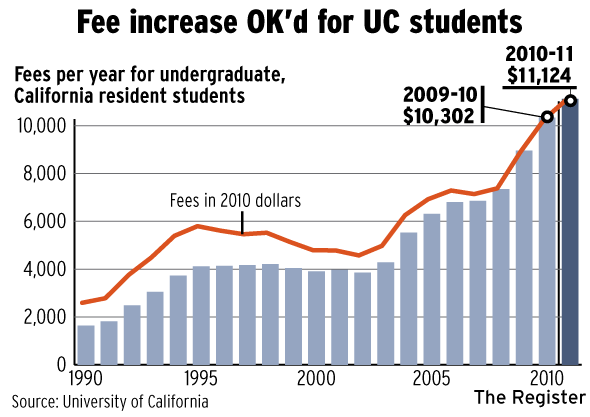The LA Times has an article today on the changing nature of in-state tuition in California's state universities. Here are a few interesting excerpts:
State funding for UC and the California State University was cut $650 million this year for each system. As a result, in-state UC undergrads will pay 18.3%, or nearly $1,900, more in tuition and fees than last year. Many will get financial aid, and students from families with annual incomes up to $120,000 may be eligible for reprieves on the latest increases.
UC leaders note that its tuition is on a par with other top public research schools. The University of Michigan at Ann Arbor will charge state residents about $14,000 this year; the University of Virginia, $11,600; and the University of Texas at Austin, $10,000. But UC student leaders say that living costs are much higher in California.
Sherry Lansing, a former Hollywood studio executive who chairs UC's Board of Regents, said the university was trying to find new revenue to replace state funding and avoid repeated tuition hikes. She said it must become more entrepreneurial to keep academic quality and student access.
Under consideration are efforts to boost private and alumni donations; reap more financial rewards from inventions and companies born in UC labs; and develop online classes that would attract a broader paying audience. The university also is seeking to save money by consolidating payroll and computer support functions.
"We are just at the beginning of this," Lansing said.
UC is one of many public universities experiencing a fundamental shift in how it operates, with more emphasis on revenue-producing activities, Hartle said.
"It doesn't mean you have a second-rate university," he said. "You can have a first-rate university but more focused on their bottom line. And when that happens, the public university starts looking more like the private university."
And also:
One way UC has tried to raise revenue has been to enroll more out-of-state undergraduates, who pay significantly more than California residents. The goal is for nonresidents to make up about 10% of UC undergraduates, still far fewer than at top public schools elsewhere. This fall, UC Berkeley will have the system's largest share of non-Californians, nearly 30% of freshmen. UC San Diego and UCLA are next, with about 18% each.
The University of Michigan's Ann Arbor campus, which has seen sharp state funding cuts over the last two decades, is sometimes seen as a possible model for UC.
About 40% of students in last year's freshman class at Michigan were from out of state, and the campus is boosting its recruitment worldwide. It has closed some research centers and increased alumni fundraising. Undergraduate fees vary by academic divisions, and the university's business school has moved to mainly private funding.
With such tactics, Michigan has been able to maintain financial aid for needy students and protect unprofitable academic departments, including the humanities, that have suffered deep cuts at other schools, said John Burkhardt, a Michigan education professor who directs the National Forum on Higher Education for the Public Good.
He said the campus is now a hybrid, with its public mission unchanged but its financing increasingly private.
UC is considering similar actions. The regents are debating whether campuses should charge undergraduates varying tuition levels, and UCLA's Anderson School of Management wants to wean itself from state subsidies in exchange for higher tuition.
